OLD DEVONPORT
. UK
www.olddevonport.uk
Webpage created: March 08, 2016
Webpage updated: January 02, 2022
-
TORPOINT FERRY (FLOATING BRIDGE)
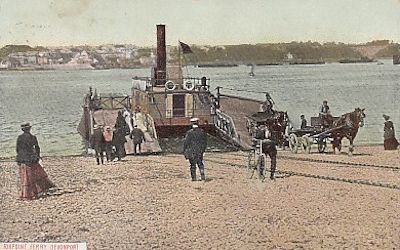
One of the first Torpoint floating bridges
at New Passage.
From a postcard.
In January 1790 the Carew and Saint Aubyn families obtained an Act of Parliament for a ferry service from Torpoint to Morice Town on the Devon shore. It started operating in 1791 was soon named the New Passage to distinguish it from the ancient Saltash ferry further up river. The new service, which was operated by rowing boats, became so popular that the Royal Mail transferred their mail coaches to it from the older ferry crossing. At that time the ferry operated from 4am until 10pm from 24 March to 29 September, with reduced hours for the remainder of the year.
In 1829 a steam boat modelled on one that had recently been introduced at Dundee in Scotland was introduced but this proved short-lived as it could not cope with the strong tides in the Hamoaze. The width of the Hamoaze at the point where the ferry was to be established was stated to be 2,550 feet at high water or 2,110 feet at low water. The greatest depth at high water was 96 feet but only 78 feet at low water. The course had to be directly across the river because of the moorings for the men-of-war. Mr James Meadows Rendel was invited to design a chain-driven floating bridge of the type recently started at Gosport, in Hampshire. This first floating bridge was installed in April 1834. To prevent the chains becoming so tight as to interrupt navigation of the harbour or to endanger their breaking, the ends of the chains were not moored to the shore but hung in shafts and heavy weights fixed to the ends.
On May 1st 1871 work started on replacing it with a brand new one. The hull was launched in 1871 by Messrs Hocking at Stonehouse while the engines and chains were constructed by Messrs Willoughby Brothers at the Great Western Docks, Plymouth. This second floating bridge can be identified by its single, very tall, funnel.
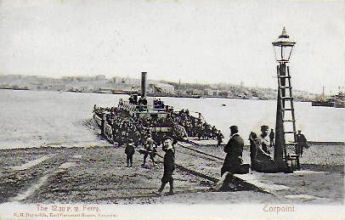
The 1871 floating bridge on the 12.30pm
ferry landing dockyard workers at Torpoint.
From a postcard by Mr E M Reynolds, of East Cornweall House, Torpoint,
dated 1905.
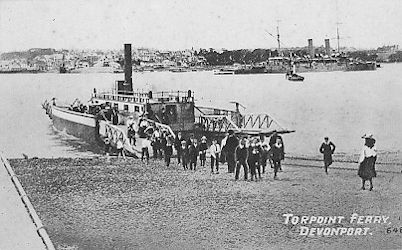
The 1871 floating bridge landing
passengers at Devonport.
From a postcard dated 1915.
A third floating bridge was brought into service at Mid-day on Saturday October 26th 1878. This one had two funnels instead of one as on the 1871 ferry.
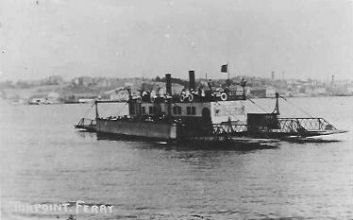
The 1878 floating bridge in mid stream.
From a postcard dated 1898.
The chains that operated the ferry often attracted the of attention of children, resulting in some accidents.
On Wednesday September 5th 1917 passage on the Torpoint and Saltash ferries was made free for servicemen and nurses in uniform but not on duty.
In November 1922 the Torpoint Ferry was acquired by Cornwall County Council under the provisions of the Ferries (Acquisition by Local Authorities) Act 1919, which received the Royal Assent on December 23rd 1919.
On the morning of Saturday July 7th 1923 there was great excitement at the Torpoint Ferry when Julia, one of the female elephants from Messrs Bostock and Wombwel's Menagerie, jumped off the Ferry as it headed to Devonport. At first the animal, which weighed over two tons, headed back to Torpoint but was eventually pointed towards the Devonport side, where she landed safely.
By April 1930 work on extending the beaches in order to take two ferries was well underway. On the Devonport side the boathouse of the Royal Naval Engineering College was demolished and the foundations removed. One of the 18-ton chains was sent by the manufacturers, Messrs Jones and Lloyd, of Cradley, Staffordshire, by rail to Saint German's Station, from where it was hauled to Torpoint by steam tractor.
It is worth recording that at that time school children from Torpoint apparently had to attend secondary school at Saltash. Torpoint Urban District Council approached the Cornwall Local Education Authority to ask for free transport for the children across the Ferry. They were allowed an annual period ticket, normally £1 1s, for ten shillings, of which the Education Authority then paid half. It is not recorded how the children made their way from New Passage to Saltash.
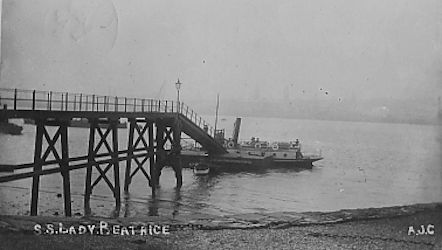
The steam launch "Lady Beatrice" working the
Torpoint Pedestrian Ferry at Torpoint landing stage, circa 1921.
From a postcard.
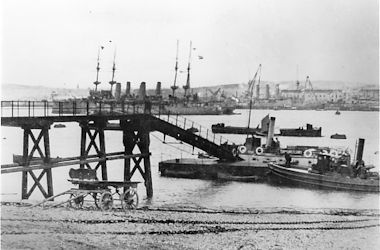
Another view of the "Lady Beatrice" at the landing stage
at Torpoint but
with a clearer view of the background.
Courtesy the Plymouth Library Service.
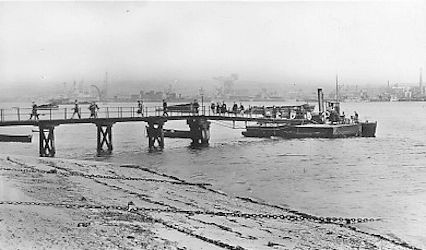
A steamer drops
passengers at the Torpoint Pontoon.
It maybe the pedestrian ferry or may be an excursion boat.
From a postcard.
Great inconvenience was caused to the traveling public during the night of Thursday July 11th/Friday July12th 1935 when completely without notice the 11pm ferry from New Passage was stopped in the middle of the Hamoaze to have its chains transferred to a replacement floating bridge that had just been renovated. The replacement vessel was towed into place and held fast by tugs. The delay meant that a party of Royal Marines missed the last motor bus from Torpoint to Scraesdon Fort and had to walk and passengers who had to wait at Torpoint for the 11.30pm ferry, running now fifteen minutes late, missed the bus connection on the Devonport side into Plymouth.
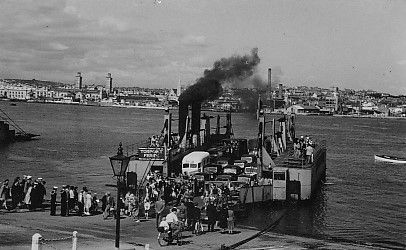
Adorned by lots of thick
black smoke, the Torpoint Ferry
arrives at Torpoint.
From the author's collection.
The Torpoint Ferry service in 1942 began with the 5.30am departure from Torpoint and the 5.45am from Devonport. There was a half-hourly service until 8.30am from Torpoint when it became every 15 minutes. At lunchtime there were ferries from Torpoint at 1pm, 1.30pm and 2pm, and Devonport at 1.15pm, 1.45pm and 2.15pm, after which the service returned to every 15 minutes. At 6.30pm (Torpoint) and 6.45pm (Devonport) the frequency dropped to half-hourly again. The last ferry from Torpoint was at 11.40pm and the last ferry from Devonport was at Midnight. On Sundays there was a half-hourly service all day between 7am (Torpoint), 7.15am (Devonport) until the last ferries detailed above.
A night ferry service was introduced in 1946. This operated at 1am,2am, 3am, 4am and 5am from Torpoint and at 1.15am, 2.15am, 3.15am, 4.15am and 5.15am from the Devonport side.
After thirty-six years as manager of the Torpoint Ferry, 65-years-old Mr Thomas Percy Endean retired on November 30th 1956. One of his most vivid memories was of the time a female elephant from a travelling menagerie fell into the river in mid stream. Mr Endean designed new ferries himself, as well as the new offices, waiting-rooms, and workshops.

The last steam ferries,
pictured at Devonport in 1960.
From a postcard.
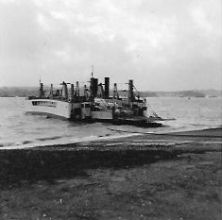
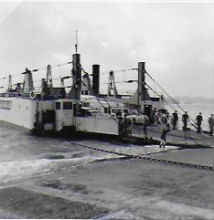
One of the last steam
ferries arrives at Devonport in 1960
and discharges what looks like a Bentley and behind it
a Goodbody's bakery delivery van.
© Brian Moseley, Plymouth.
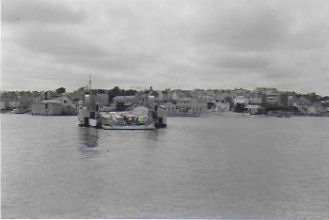
One of the new Thornycroft diesel-electric vessels in mid stream, 1960.
Two new diesel-electric chain ferries were introduced in 1961 and were christened "Lynher" and "Tamar". A third ferry was brought in to service in 1969 and named "Plym". Between 1986 and 1991 all three had their hulls extended and their engines replaced, resulting in an increase in capacity of 60%.
They have now all been replaced, starting with "Plym II" in December
2004 and followed by "Tamar II" and "Lynher II". These latest versions
have a central control room and a huge searchlight for locating people lost
overboard in the dark.